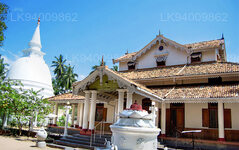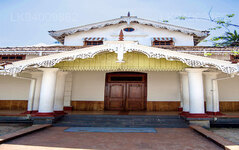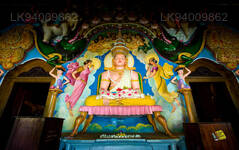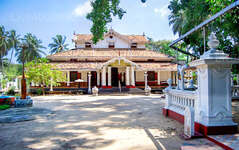
/páginas/transferências
Colombo, a capital do Sri Lanka, é uma cidade dinâmica que mistura tradição e modernidade. Ela exibe arquitetura colonial, mercados animados e templos budistas serenos. Com uma gastronomia diversificada, um horizonte crescente e belas praias, é um centro vibrante de negócios, cultura e turismo, oferecendo uma porta de entrada para explorar as maravilhas do Sri Lanka.
Isipathanaramaya Temple
Colombo is Sri Lanka’s capital, the center of trade and commerce for the entire country. It’s also one of the most populated cities on the island. Walking through the streets of Colombo, its quite hard to remember that the capital is a comparatively young city. It’s oldest buildings are only a few centuries old at most, and not at all comparable to the millennia-old structures that spread across Anuradhapura, Polonnaruwa and many other places within Sri Lanka. Therefore, it comes as no surprise that its oldest Buddhist Temples are only a century old or so.
Isipathanaramaya located in Havelock Town (Colombo 05) is one such Buddhist Temple that’s one of the oldest within the city. It was built in 1916, by a wealthy merchant named Duenuge Disan Pedris in the memory of his late son Captain Henry Pedris, who had been executed by the British on false allegations of incitement of the racial riots in 1915.
As the story goes, that was the year of the Sinhala-Muslim riots that started in Kandy because of reports of a group of Muslims throwing stones at a Buddhist event. It spread across the island like wildfire, and British governor came to the verge of losing control of the population. He declared martial law, and ordered a death-without-trial order on any person deemed a rioter. Unfortunately the illustrious and well-known Captain Henry, had been the object of envy for many locals. One of them, Solomon Dias Bandaranaike, who was the main native translator decided to use this opportunity to get rid of this thorn that threatened his power. He created false charges that Henry was involved in the riots and the Captain was branded traitor and executed without trial. His body was buried in dishonor, much to the distress of his family. It was only several years later that the truth came out and the late Captain was cleared of his charges.
In the meantime, Henry’s grieving father – who had been having high hopes for his heir, built a temple in his memory on a 2 hectare piece of land that had been part of the family’s properties since 1905. He also did several other good deeds that would pass on the name of his son Henry Pedris down through history, despite his early death.
Duenuge Pedris spared no effort or money when building the temple. It was built with a mixture of traditional elements and the architectural trends of the era. The murals and statues that decorate the temple are a major part of Isipathanaramaya’s attraction. The paintings were done by Master Artist Sarlis in 1920-21, and are traditional designs of Buddhist religious significance. However, they have gained prominence due to the unique, exuberant and realistic style that was used.
The temple slowly gained fame. It reached such extent that in the 1950s the street that the temple was located – Greenlands Road, and the school down the same road – Greenlands College, received a name change to Isipathana Mawatha and Isipathana Maha Vidyalaya respectively.
Today, the overall layout of Isipathanaramaya remains in its original state, with its old colonial era building, brilliant white stupa, and shady Bo Tree. The main building is beautifully maintained preserving its history. One of the most recent additions was the 12m tall standing Buddha, built in 2016 at a cost of Rs 4.5 Million.
Isipathanaramaya is well worth visiting for its historical connotations and beautiful murals.
Sobre o Distrito de Colombo
Colombo é a maior cidade e capital comercial do Sri Lanka. Está localizada na costa oeste da ilha e adjacente a Sri Jayewardenepura Kotte, a capital do Sri Lanka. Colombo é uma cidade movimentada e vibrante, com uma mistura de vida moderna e edifícios e ruínas coloniais, e uma população de 647.100 habitantes. A Região Metropolitana de Colombo, definida pelos distritos de Colombo, Gampaha e Kalutara, tem uma população estimada de 5.648.000 habitantes e cobre uma área de 3.694,20 km². Colombo é uma cidade multiétnica e multicultural. É a cidade mais populosa do Sri Lanka, com 642.163 habitantes vivendo dentro dos limites da cidade. A população de Colombo é uma mistura de vários grupos étnicos, principalmente cingaleses, mouros e tâmeis. Há também pequenas comunidades de pessoas de origem chinesa, portuguesa, holandesa, malaia e indiana vivendo na cidade, bem como numerosos expatriados europeus. A grande maioria das empresas cingalesas tem sua sede em Colombo. Algumas das indústrias incluem produtos químicos, têxteis, vidro, cimento, artigos de couro, móveis e joias. No centro da cidade está localizado o segundo edifício mais alto do sul da Ásia: o World Trade Center.
Sobre o Distrito de Colombo
A Província Ocidental é a província mais densamente povoada do Sri Lanka. Abriga a capital legislativa, Sri Jayawardenepura Kotte, e Colombo, o centro administrativo e comercial do país. A Província Ocidental é dividida em três distritos principais: Colombo (642 km²), Gampaha (1.386,6 km²) e Kalutara (1.606 km²). Como centro econômico do Sri Lanka, todas as grandes corporações locais e internacionais estão presentes na cidade, assim como todos os grandes estilistas e varejistas de rua. Portanto, prepare-se para se deliciar com as compras na Província Ocidental. Com a maior população de todas as províncias, quase todas as principais instituições de ensino da ilha estão localizadas na Província Ocidental. As universidades da província incluem a Universidade de Colombo, a Universidade de Sri Jayewardenepura, a Universidade de Kelaniya, a Universidade Aberta do Sri Lanka, a Universidade Budista e Pali do Sri Lanka, a Universidade de Defesa General Sir John Kotelawala e a Universidade de Moratuwa. A província ocidental tem a maior quantidade de escolas do país, que inclui escolas nacionais, provinciais, privadas e internacionais.










































